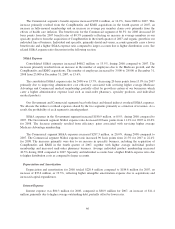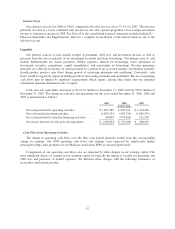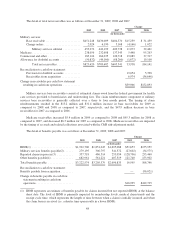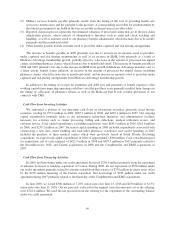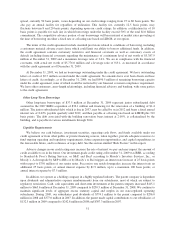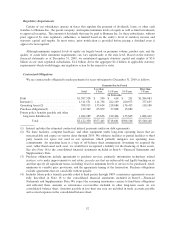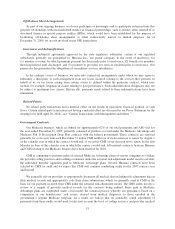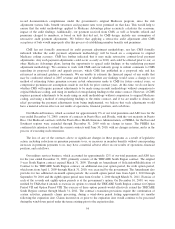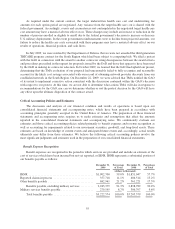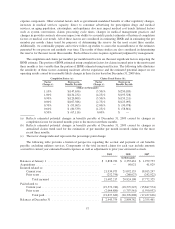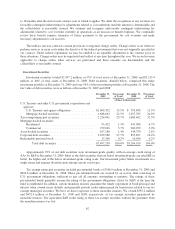Humana 2009 Annual Report Download - page 65
Download and view the complete annual report
Please find page 65 of the 2009 Humana annual report below. You can navigate through the pages in the report by either clicking on the pages listed below, or by using the keyword search tool below to find specific information within the annual report.
As required under the current contract, the target underwritten health care cost and underwriting fee
amounts for each option period are negotiated. Any variance from the target health care cost is shared with the
federal government. Accordingly, events and circumstances not contemplated in the negotiated target health care
cost amount may have a material adverse effect on us. These changes may include an increase or reduction in the
number of persons enrolled or eligible to enroll due to the federal government’s decision to increase or decrease
U.S. military deployments. In the event government reimbursements were to decline from projected amounts, our
failure to reduce the health care costs associated with these programs may have a material adverse effect on our
results of operations, financial position, and cash flows.
In July 2009, we were notified by the Department of Defense that we were not awarded the third generation
TRICARE program contract for the South Region which had been subject to competing bids. We filed a protest
with the GAO in connection with the award to another contractor citing discrepancies between the award criteria
and procedures prescribed in the request for proposals issued by the DoD and those that appear to have been used
by the DoD in making its contractor selection. In October 2009, we learned that the GAO had upheld our protest,
determining that the TMA evaluation of our proposal had unreasonably failed to fully recognize and reasonably
account for the likely cost savings associated with our record of obtaining network provider discounts from our
established network in the South Region. On December 22, 2009, we were advised that TMA notified the GAO
of its intent to implement corrective action consistent with the discussion contained within the GAO’s decision
with respect to our protest. At this time, we are not able to determine what actions TMA will take in response to
recommendations by the GAO, nor can we determine whether or not the protest decision by the GAO will have
any effect upon the ultimate disposition of the contract award.
Critical Accounting Policies and Estimates
The discussion and analysis of our financial condition and results of operations is based upon our
consolidated financial statements and accompanying notes, which have been prepared in accordance with
accounting principles generally accepted in the United States of America. The preparation of these financial
statements and accompanying notes requires us to make estimates and assumptions that affect the amounts
reported in the consolidated financial statements and accompanying notes. We continuously evaluate our
estimates and those critical accounting policies related primarily to benefit expenses and revenue recognition as
well as accounting for impairments related to our investment securities, goodwill, and long-lived assets. These
estimates are based on knowledge of current events and anticipated future events and, accordingly, actual results
ultimately may differ from those estimates. We believe the following critical accounting policies involve the
most significant judgments and estimates used in the preparation of our consolidated financial statements.
Benefit Expense Recognition
Benefit expenses are recognized in the period in which services are provided and include an estimate of the
cost of services which have been incurred but not yet reported, or IBNR. IBNR represents a substantial portion of
our benefits payable as follows:
December 31,
2009
Percentage
of Total
December 31,
2008
Percentage
of Total
(dollars in thousands)
IBNR ............................................ $1,902,700 59.0% $1,851,047 57.7%
Reported claims in process ........................... 357,718 11.1% 486,514 15.2%
Other benefits payable ............................... 682,961 21.2% 561,221 17.5%
Benefits payable, excluding military services ......... 2,943,379 91.3% 2,898,782 90.4%
Military services benefits payable ...................... 279,195 8.7% 306,797 9.6%
Total benefits payable ........................... $3,222,574 100.0% $3,205,579 100.0%
55



